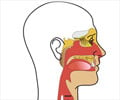Inspite of a brave initial fight by the White blood cells to combat chronic virus infecions like HIV or Hepatitis C, the infection persists due to immune exhaustion.
Inspite of a brave initial fight by the White blood cells to combat chronic virus infecions like HIV or Hepatitis C, the infection persists due to immune exhaustion.
Researchers at Emory Vaccine Center have demonstrated that exhaustion is driven by how the immune system detects infecting viruses.To recognize the presence of a viral infection, T cells must be presented with bits of viral protein in a molecular frame supplied by other cells in the body called MHC (major histocompatibility complex) class I molecules.
In mice infected by lymphocytic choriomeningitis virus (LCMV), T cells became more or less exhausted depending on how much properly framed viral protein was available.
Insights from the research could guide efforts to revive the immune system in people with chronic viral infections. The results are published online this week in the Proceedings of the National Academy of Sciences.
Working with Vaccine Center director Rafi Ahmed, PhD, postdoctoral fellow Scott Mueller, PhD, examined the effects of limiting what kind of cells could display the viral antigens.
Ahmed is professor of microbiology and immunology at Emory University School of Medicine and a Georgia Research Alliance Eminent Scholar.
Advertisement
"We were trying to sort out which of several factors contribute to T cell exhaustion, such as viral antigen, inflammation and where the immune system encounters the virus," Mueller says. "What came out of these experiments allowed us to answer a broad question: the role of antigen in driving exhaustion."
Advertisement
"Early on, the T cells were healthier because they saw less antigen, and only saw it on cells that came from bone marrow," Mueller says. "But later, the immune system had trouble getting rid of the virus because the T cells couldn't recognize infection in cells that were not able to present the viral antigens."
Source-Eurekalert
SAV














